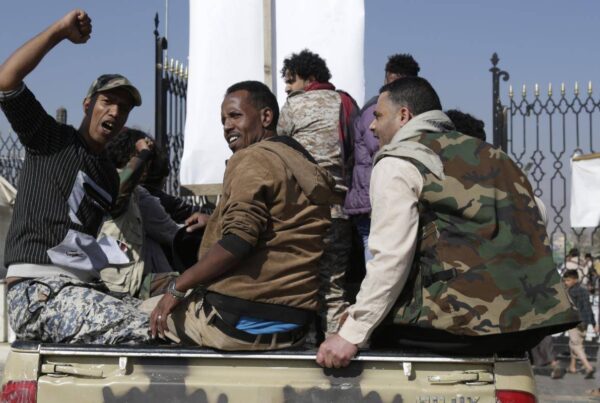By Larry Attree and Farea al Muslimi
After 15 years of US efforts to combat terror and achieve stability in Yemen, a new study by Saferworld concludes that these efforts—as in the cases of Afghanistan and Somalia—have badly backfired. Today, Yemen requires not more military intervention, but strategies to counter corrupt and abusive government and to show its people that their security and rights matter.
Feeding off deep public resentment of an abusive and corrupt state, Houthi rebels and other militants have taken charge of large swathes of Yemen. With the country locked in a brutal civil war that has drawn in regional powers, al-Qaeda in the Arabian Peninsula remains strong and the Islamic State (ISIS or IS) launched several bloody attacks in Yemen last year.
As they faced off with al-Qaeda in Yemen, US Presidents George W. Bush and Barack Obama publicly praised the commitment of their counterparts, Yemeni Presidents Ali Abdullah Saleh and Abd Rabbuh Mansur Hadi, to combat terrorism. But in reality Yemen’s government appears to have privately colluded with Islamist militants, allowing major prison breaks of al-Qaeda operatives in both 2006 and 2014. In some cases public committees on the government payroll (for example in Abyan governorate) include individuals who have fought for al-Qaeda.
In 2006, al-Qaeda began regaining momentum in Yemen, a development that proved lucrative for the country’s government. After the 2009 “Christmas Day” bombing, the Friends of Yemen (a group of governments convened to support stability in Yemen) was shaken enough to pledge $8 billion to the regime in subsequent years. The US alone provided more than $600 million in counter-terrorism and security assistance.
Yemen’s government, however, often used Western counterterrorism support to crush dissent and duck pressure to reform. President Saleh’s family controlled the elite counter-terror forces, trained with US support, and primarily used them to protect the capital and the presidential palace rather than pursue terrorists. More recently, US-supplied military equipment worth millions of dollars has ended up in the hands of Houthi rebels (whom the US is backing regional allies to fight).
In 2011, when popular discontent exploded into mass civil unrest, the US helped broker deals to get rid of President Saleh. But these transition deals left Yemen’s key elites and main political parties in charge, and failed to satisfy the Houthis, Southern rebels, and other groups. Although President Hadi’s administration talked tough on counterterrorism, it failed to address popular grievances, including food insecurity, water scarcity, commodity price hikes, and lack of services.
In fact, Yemen’s instability is driven more by abusive, corrupt governance than by terrorism. The Hadi administration is not only soft on terror groups, but also deeply corrupt. Thanks to foreign aid, the government’s 2014 budget of $14 billion was triple that of 2004. But this money apparently disappeared into a “black hole,” with practically nothing spent on investment and infrastructure.
Violence Begets Violence
Another strand of US counter-terror strategy in Yemen was its program of “targeted killings.” The US used airstrikes to attack al-Qaeda in Yemen without deploying significant ground forces. Some al-Qaeda operatives have been killed under the program, but targeted killings ultimately generated huge resentment and fed support for anti-Western militants. Local media have described drone attacks as massacres, and jihadi online fora have been filled with pictures of victims’ bodies. Al-Qaeda leaders have grieved with victims’ families and accused the US of waging war against all Muslims.
The US is now backing a Saudi-led regional military coalition against Houthi rebels, who the Saudis view as Iranian proxies. The bombing, blockade, and ground operations have devastated an already destitute population, with daily reports of deadly attacks on civilians, hospitals, schools, markets, or ambulances by all sides. At least 5,700 people have died in the hostilities since March 2015, with 2.3 million people displaced and 21.2 million people requiring aid.
Now, as violence becomes all too normal, al-Qaeda and IS seem poised to take advantage of the chaos. The strategy to counter terrorism and achieve stability in Yemen has failed. Worse still, the many Yemenis victimized in the process may well blame their suffering on the self-seeking security policies of foreign governments.
When counter-terror efforts in Yemen are compared to those in other contexts, it is both striking and depressing to note the parallels. Parallel studies in Afghanistan and Somalia document how counter-terror objectives and military approaches crowded out a focus on effective conflict management and peacebuilding. In both these contexts, violence, abuse, and corruption fed into grievances and militancy, while efforts to work with society to achieve reconciliation and shape better governing institutions have been neglected.
In Somalia, the US-backed invasion of 2006 was meant to prevent the country becoming a safe haven for terrorists, but it largely brought about the rise of al-Shabaab. Today, Kenyan forces, which the US is backing to stabilize Somalia, have been accused of intentionally attacking crowds of Somali civilians and sharing profits from illicit charcoal and sugar trade with al-Shabaab.
In Afghanistan, the ministries of interior, defense and foreign affairs and the national directorate of security were all given to known warlords in the first two post-Taliban administrations. The culture of predation became so profound that many communities came to see the Taliban as a more accountable alternative. Such examples illustrate how significant conflict drivers have been neglected, and explain why groups like al-Shabaab and the Taliban remain strong and active despite massive investments in forceful attempts to suppress them.
Taking a Different Approach
To move forward in Yemen—and in Afghanistan and Somalia—there needs to be a step-by-step process to achieve peace. This means finding alternatives to using force wherever possible, and showing Yemen’s people that their security and rights matter.
It also means rethinking security assistance to corrupt, abusive governments. Corruption and abuse have left the public destitute and, in some cases, ready to back armed rebellions. Going forward, the US must use all the sanctions and incentives available to press for actors in Yemen to abandon violence and start to work in the public interest.
In Yemen and the wider region, short-term energy, security, and economic interests have locked the West into support for Saudi Arabia. However, backing the Kingdom to play out its rivalry with Iran in Yemen has been an unmitigated disaster. It has failed militarily while causing tremendous human suffering and escalating the conflict for the long term. The West needs to find effective ways of challenging damaging behavior and encouraging constructive contributions. As part of this, the US, France, and UK need to stop permitting billions of dollars in bomb sales for use in Yemen.
What is needed in Yemen is not more military intervention, but rather a strategy to bring all parties back to the negotiating table. And when they get there, the US needs to help amplify the voices of Yemeni society. Countries like Afghanistan, Somalia, and Yemen need, but seldom get, Western support for human rights defenders, civil society groups, community voices, local development initiatives, and moderate political, religious and tribal actors. If militants and corrupt elites are forced to listen to voices that oppose violence, the future could look much better for countries like Yemen.








